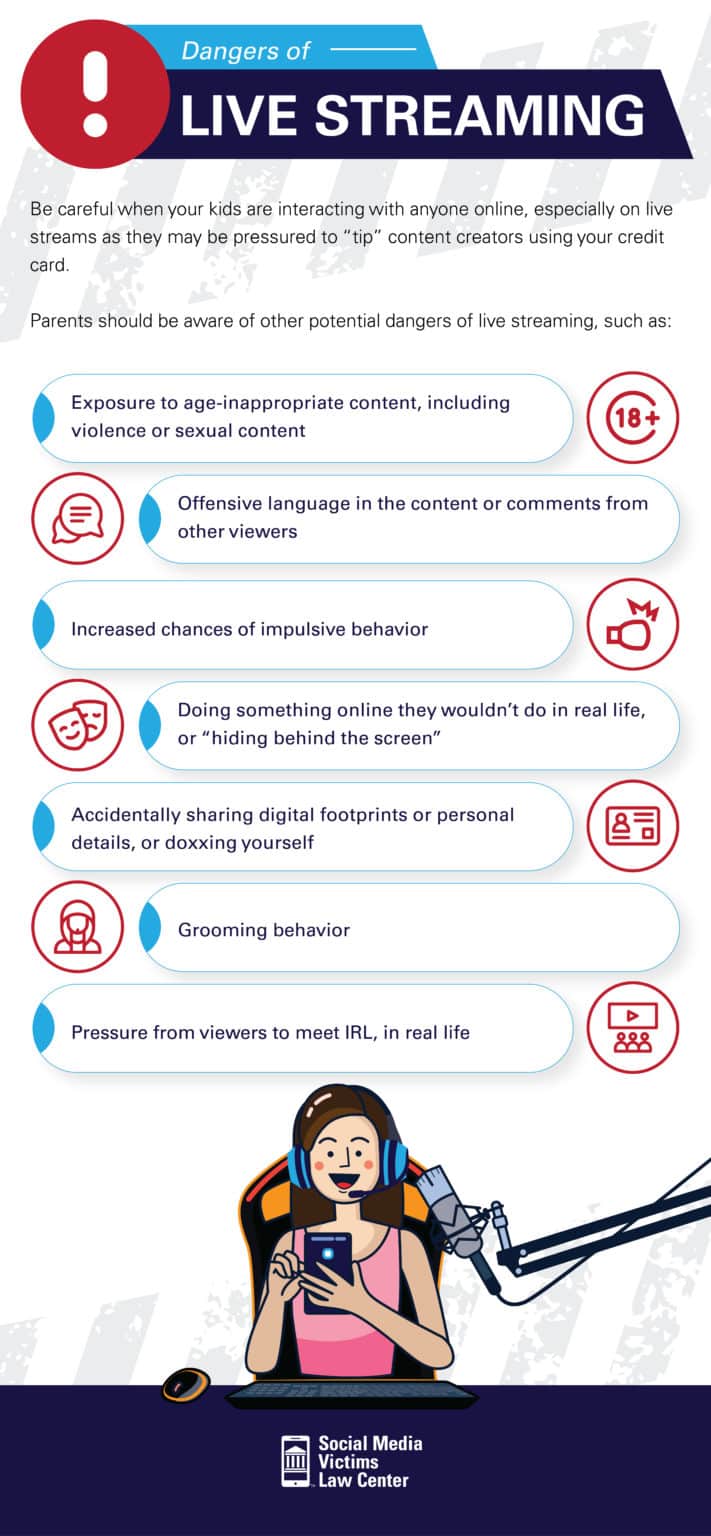Live Streaming: A Parent’s Guide

- Content last updated on:
- June 12, 2025
Written and edited by our team of expert legal content writers and reviewed and approved by

- Content last updated on:
- June 12, 2025
You might have noticed your kids and teens watching live videos on their phones or tablets via social media apps. Live streaming is a modern way for people to interact with one another, create unique content, and connect with fans and followers.
The videos can be of anything, such as how-to demonstrations, self-produced product promotions, scenery on a vacation, and activities like doing homework or playing a video game in real time.
However, more disturbingly, live streaming apps can be used to capture sexual content and violent behavior.
As a parent, you may already have set certain limitations on your child’s social media access and exposure, like what apps they can use, what they are allowed to post, or who they are allowed to follow or accept as a friend. However, you may not be aware of the hidden dangers of live streaming.
What is live streaming?

What apps have live streaming?
A study done by PrivacyHQ reveals that the top three social media platforms parents allow their children to use before the age of 13 are YouTube, Instagram, and TikTok.
Adolescents have access to, and even permission to use, a range of apps that feature a live stream function:
- Twitch TV
- Instagram Live Stream
- YouTube Live
- TikTok LIVE
- House Party
- Facebook Live
Live streaming is uncensored and aired in real time, unlike videos on platforms like YouTube, which may have been prerecorded and edited.
Users can make their live streams private, like with Zoom or Skype, where only invited users can view them. Alternatively, users can air their streams to all subscribers on their profile or all users on the platform, like with TikTok LIVE streaming.
What makes live streaming so popular?
Live streaming allows users to air anything they want and broadcast it to their friends or anyone willing to watch. Being “in the moment” and viewing something across the country or across the world in real time provides a sense of interconnectivity.
According to DeStream, streaming is popular for the level of interactivity it creates between streamers and viewers, the opportunity to watch professionals live, and the ability to satisfy the need for communication.
Many kids aspire to be more like their favorite content creators or internet celebrities. Live streams can be used to hold interactive Q&A sessions or create back-and-forth relationships between content creators and viewers. Creators can address individual viewers and build their brand through authentic connections.
When used positively, live streaming can be great. It helps teens and children improve their confidence and public speaking skills, show off a particular skill, or build relationships in a niche hobby community.
Connecting with others who share similar interests or are going through similar life experiences can help kids feel less alone. Some young people may feel less socially isolated after connecting with others on live streams.

Is live streaming safe?
Parents should be aware of the potential dangers of live streaming, such as:
- Exposure to age-inappropriate content, including violence or sexual material
- Offensive language in the stream or comments from other viewers
- Increased chances of impulsive behavior
- Doing something online they wouldn’t do in real life, or “hiding behind the screen”
- Accidentally sharing digital footprints or personal details
Viewers can interact with the live stream, which provides a more authentic experience. They can give the content creator virtual coins or even actual money. Be careful when your kids are interacting with anyone online, however, as they may be pressured to “tip” content creators using your credit card.
Live streams have dangers for both viewers and creators. Doxxing is a term that means discovering someone’s real identity by using clues they might have dropped online.
Predators can look for vulnerable children to manipulate, using grooming techniques such as compliments, attention, promises of being internet famous, or giving money and gifts.
Over time, these predators may sexually abuse children or teens by pressuring them to engage in sexual activity, such as sending nude pictures or videos, coercing the child into watching inappropriate videos, or even meeting the predator in person.
If your child or teen live streams, it’s important to ensure they are being safe and smart while doing so. Depending on the platform, strangers can easily view the live stream and initiate contact. Where your child is located can also pose risks, for instance if they’re in their bedroom, in front of a window that looks out onto a business or establishment, or if they show a piece of mail that has your address on it.
The National Center for Missing & Exploited Children is familiar with the risks and threats of live streaming. Despite being in the same room as your child and thinking they are safe, they can still be victimized even if they do not communicate with the perpetrator.
Children can see comments from viewers that instruct them to engage in inappropriate behaviors and even divulge personal information, such as their school name, phone number, and home address. It’s important you and your child take the proper precautions when participating in a live stream, whether they are the streamer or viewer.

How to Keep Your Child Safe
Keeping your child safe online starts with open conversation and a dialogue that is part of your family life. You can ask about what they are watching and what they enjoy about their favorite content creator.
Supervise younger children, and don’t allow devices behind closed doors. This may mean a change from your current policy, and if it is, prepare for pushback. Younger children, especially those under 12, should be supervised when online, and their interactions with live streams and other video apps should remain under your guidance.
With your child, go through the safety and privacy settings on their devices. Making this something that you do together forms a feeling that you are on the same team, protecting your family, instead of a parent dictating what a child may and may not do.
Explain what each privacy and safety feature is for. This may prompt an organic conversation about online dangers. Warn your children about requests for private chats from other users, especially those they don’t know in real life. Some child predators try to isolate children, conversing outside your supervision or the group where conversations are more closely moderated.
Many more influences exist for your child now than when you were growing up. The more you know about popular live streaming apps and the content your kids are watching, the better you can protect them from predators or fraud.
Keep the dialogue open, and show interest in your child’s favorite streams. Ultimately, you are their protection against the dangers of the internet.
Has your child been sexually abused through a live streaming app? Have you experienced fraud through live stream “tipping” or another monetary gift? We can help. Social Media Victims Law Center helps victims of cyber assault. Contact us today for a confidential consultation about your case.
